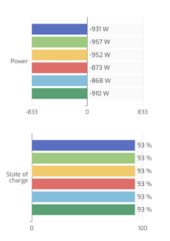SunDave
Solar Enthusiast
This is not a hypothetical question. I have 6 Pytes 48100R batteries, in a forest RB enclosure. Pytes right from the factory sends cabling that puts two batteries vertically, and the other two sets horizontally. Basically it makes it so that none of the batteries have the same length 4 gauge run to the bus bar. Not standard connectors either so hard to swap.
Now the questions:
1. Is this actually a problem?
2. If so, how much lifetime loss am I looking at?
I could reconfigure the batteries to new positions every couple years. Or get some custom cables made with Surlock connectors and get all 6 batteries to the bus bar individually instead of in sets of two.
I have been watching SOC since I got solar-assistant. I have a rather small array, so at times when I don't get a full charge for 2 weeks, I have seen it go as far as 10-11% difference in SOC (74% on lowest battery of the 6, and 85% on the highest). If I get a full charge every few days they don't drift more than 2-3%.
There are also minor differences in draw. When the dryer is running, it could be pulling 910 watts from one battery and 880 watts from another for example.
Now the questions:
1. Is this actually a problem?
2. If so, how much lifetime loss am I looking at?
I could reconfigure the batteries to new positions every couple years. Or get some custom cables made with Surlock connectors and get all 6 batteries to the bus bar individually instead of in sets of two.
I have been watching SOC since I got solar-assistant. I have a rather small array, so at times when I don't get a full charge for 2 weeks, I have seen it go as far as 10-11% difference in SOC (74% on lowest battery of the 6, and 85% on the highest). If I get a full charge every few days they don't drift more than 2-3%.
There are also minor differences in draw. When the dryer is running, it could be pulling 910 watts from one battery and 880 watts from another for example.



